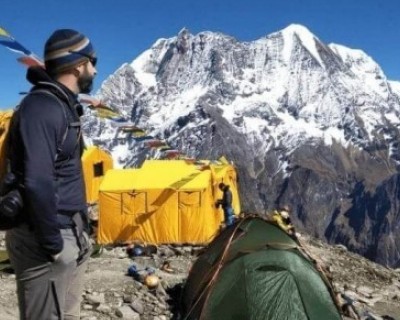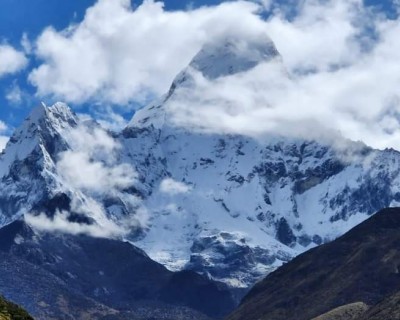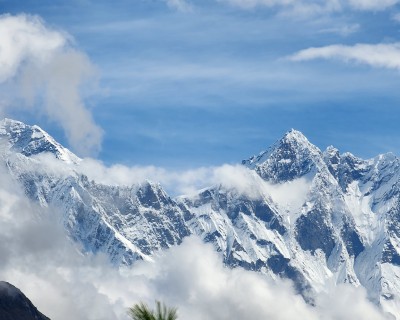"To trek to the foot of the world’s tallest mountain instills a gushing feeling of adventure into one's mind. Everest Base Camp Trek is the epitome of adventure."
The Everest Base Camp Trek surely is the most popular trek in Nepal. Everest Base Camp Trek is the perfect way to experience the Himalayas along with the natural and cultural beauties of the Everest region. The adventure of the Everest Base Camp Trek begins with the scenic flight to Lukla. You witness the diverse terrain changing below you as you approach a thrilling landing at the Tenzing-Hillary Airport in Lukla. This airport is often described as one of the most dangerous in the world due to its strange location and unusually short runway. As you begin your trek, you pass through several Sherpa villages that reside in the foothills of the Himalayas. During the first few days of the trek, you will be walking through lush green forests and fertile vegetation of the lower Everest region. Within the confined spaces of the Sagarmatha National Park (titled as a natural UNESCO World Heritage Site), the forests are filled with the Himalayan flora and fauna. As the forests and the greenery start to decrease, the views of the astonishing peaks uncover. On your path, you will come across Namche Bazaar, Tengboche, Dingboche, and many more villages that have their own Sherpa spirits. You will find yourself entangled in a spiritual trance as you walk through Mani stones, chortens, monasteries, and prayer flags flapping above and besides you. Finally, as you reach the Everest Base Camp (5364m), the scene of the Khumbu Icefall, Glacier, and the surrounding Himalayas are stupendous, to say the least. The trek takes one final stop at Kalapatthar where you can witness the best possible view of the Mt. Everest (8848m) and its neighboring peaks.
Difficulty Level of EBC Trek
The Everest Base Camp Trek is moderately difficult and the Everest Base Camp Trek distance is also fairly moderate. For its most uphill and down-hill walks with plenty of acclimatization time, you do not require much experience nor extreme physical fitness- but a tad bit of preparation such as; cardio exercises, flexibility training, and practice treks can be useful. The Everest Base Camp Trek is a splendid journey to the foot of the world’s tallest mountain. Filled with prominent features like; views of the mountains, experiencing the lifestyle of the mountainous people, witnessing the Himalayan flora and fauna and many more attractions- the Everest Base Camp Trek is definitely worth the shot.

Everest Base Camp Brief Itinerary
Day 1: Arrival in Kathmandu. Preparation for the trek.
Day 2: Fly from Kathmandu to Lukla. Start trekking to Phakding – 9 km, (4 hours), altitude: 2,800/2,610m
Day 3: Trek from Phakding to Namche Bazaar – 12 km (6 hours), altitude: 3,441m
Day 4: Acclimatization day at Namche Bazaar
Day 5: Trek from Namche Bazaar to Tengboche – 10 km (6 hours), altitude: 3,860m
Day 6: Hike from Tengboche to Dingboche – 12 km (6 hours), altitude: 4,350m
Day 7: Acclimatization day in Dingboche. Explore the area.
Day 8: Trek from Dingboche to Lobuche – 12 km (7 hours), altitude: 4,910m
Day 9: Hike from Lobuche to Gorakshep to Everest Base Camp and back to Gorakshep – 15 km (8 hours), altitude: 5,170m
Day 10: Hike from Gorakshep to Kalapatthar and then to Pheriche – 13 km (7 hours), altitude: 5,554/4,280m
Day 11: Trek back from Pheriche to Namche Bazaar – 14 km (8 hours)
Day 12: Hike from Namche Bazaar to the airstrip at Lukla – 15 km (8 hours)
Day 13: Fly back to Kathmandu
Day 14: Departure from Kathmandu
Everest Base Camp Trek Distance and Itinerary
Day 1: Arrival in Kathmandu and preparation for the trek.
As you enter Nepal, the Himalayas will offer you a teaser of what lies ahead on the trek and land at the Tribhuvan International Airport in Kathmandu. A company representative will receive you at the airport and take you to your hotel in the valley. You may visit various places around the valley or relax in your hotel room. In the meantime, you can check on the weather or do some further research about the trek. Make sure you have packed all the essentials in your bags.
Day 2: Fly from Kathmandu to Lukla, then walk to Phakding – 9 km, (4 hours), altitude: 2,840/2,610m
Today, you will catch an early flight to Lukla. This 25-minute air trip is considered as one of the most thrilling parts of the trek. Landing at the narrow airport on a hilltop gives you an incredible adrenaline rush. As you approach the hill surrounded with mountains and forests, your adventure begins as you land on this narrow airstrip. Since Lukla is located at an altitude of 2,840 meters and Phakding is at around 2,610 meters, you will be descending on today’s walk. You will be walking at a distance of approximately 9 kilometers today. The trail leading to Phakding has amazing terrain with views of mountains such as the Kusum Khangkaru and many more. The estimated time to arrive at Phakding is 4 hours. Here, you will find plenty of lodges and teahouses to stay for the night.
Day 3: Trek from Phakding to Namche Bazaar – 12 km (6 hours), altitude: 3,441m
After having breakfast at Phakding, you head out to the popular lively town of Namche Bazaar. 12 kilometers away from Phakding. Namche rests at an altitude of 3,440 meters. You will be passing through several villages including Jorsalle and Monjo. Monjo is the entry point of the Sagarmatha National Park, a natural UNESCO world heritage site. Venturing through the national park, you will come across the many virtues of this park. Amidst it alpine woods, rivers, and deciduous forests, you will come across fascinating species of rare animals such as snow leopard, Himalayan Tahr, Himalayan Black Bear, etc. Approximately after 6 hours of trekking, you arrive at Namche Bazaar. Namche Bazaar is also the commercial hub of the Khumbu region, suitable for traders and trekkers alike. Its location on the mountainside also provides views of the Thamserku and the Kongde Ri Himalaya ranges.
Day 4: Acclimatization day at Namche Bazaar
Today, you will spend the entire day at Namche Bazaar for acclimatization. You can wander around the village and explore the region. The Syangboche airstrip lies on a hill just above the town. It is a vantage point for panoramic views of Namche and the glorious peaks in the Everest ranges. Khumjung and Khunde villages to the north of Namche Bazaar are also viable hiking destinations. These villages showcase the glorious Sherpa culture and lifestyle.
Hike to Everest View Hotel (Walking Distance: 3-4 km) Duration: 3-4 Hours.
Another option is to hike to the Everest View Hotel. At an altitude of 3,962 meters above sea level, the Everest View hotel is the highest located hotel in the world. It is about 3 to 4 kilometers away from Namche Bazaar and can be covered in 4 hours. From the hotel, you can get views of the Everest itself and the neighboring massifs. Enjoy a cup of warm Tibetan butter tea as the mountains ahead entertain you.
Day 5: Trek from Namche Bazaar to Tengboche – 10 km (6 hours), altitude: 3,860m
After you spend a day acclimatizing at Namche, you will head out to Tengboche. Today’s trek has an easy trail of about 10 kilometers. The trail is filled with rivers, hills, and beautiful scenery of the mountains. As you walk along the Dudh Koshi River, within 6 hours you arrive at Tengboche - a village surrounded by hills covered with Rhododendron forests. This village is also famous for the Tengboche monastery; the largest monastery in Khumbu region. Also regarded as the spiritual hub of this region, the Tengboche monastery is an important Buddhist heritage. Tengboche Monastery allows you to witness the views of Mt. Ama Dablam (6856m), the Mt. Everest (8848m), and Lhotse (8414m).
Day 6: Hike from Tengboche to Dingboche – 12 km (6 hours), altitude: 4,410m
Today you will head out to the “summer valley’- Dingboche. Your trail crosses the Imja River and takes you to the village of Dingboche. Dingboche is located approximately 12 kilometers away from Tengboche and is at an altitude of 4,410 meters. From the vantage points around Dingboche, you can acquire amazing views of Lhotse (8414m), Ama Dablam (6856m), and Island Peak (6189m) among others. Within 6 hours of trekking, you arrive at the valley of Dingboche. In this valley, you will come across a long wall which protects the farms from the cold winds from the Imja valley.
Day 7: Acclimatization day in Dingboche. Explore the area.
Again, you spend another day for acclimatization at Dingboche. You can explore the summer valley or choose to hike up to Nangkartshang, Nangkartshang is located approximately 6 kilometers away from Dingboche at an elevation of 5,075 meters around the edges of the Chhukung valley. Thus, the hike is steep and may be strenuous. The walk is about 5 to 6 hours and you reach your destination. As you reach the top, a marvelous panoramic view awaits you. Some prominent peaks you will witness are Lobuche East (6119m), Lobuche West (6145m), Taboche (6367m), and Ama Dablam (6856m) among others. If the weather is in your favor, you can also spot Makalu (8463m)- the fifth tallest peak on Earth. The view of Pheriche from here is also a highlight of this hike.
Day 8: Trek from Dingboche to Lobuche – 12 km (7 hours), altitude: 4,910m
Today, you will head towards Lobuche. Lobuche is located 12 kilometers away from Dingboche and is situated at an elevation of 4,910 meters. En route lies Pheriche (4,280 meters) where you will come across the Trekker’s Aid Post. Run by a group of western volunteering doctors along with the assistance of the Himalayan Rescue Association, this post helps trekkers in various ways possible for their trek. As you walk further through the trails, you arrive at the Khumbu Glacier. You can get spectacular views of Mahalangur, Lingtren, and Pumo Ri ranges from this glacier. After around 7 hours of walking, you arrive at Lobuche.
Day 9: Hike from Lobuche to Gorakshep to Everest Base Camp and back to Gorakshep – 15 km (8 hours), altitude: 5,170m
Today is probably the most exciting and anticipated day of the trip. You will finally be heading towards the foot of the Everest. But keep your emotions intact and commence your trek with a slow walk. It is crucial that you maintain a steady pace to avoid altitude sickness. With the Khumbu Glacier to your right accompanied by snow-clad peaks, today’s walk is arguably one of the best days of the trip. Around 4 kilometers from Lobuche lies Gorakshep at an altitude of 5,140 meters. You will continue trekking towards the Everest Base Camp. Once you reach the base camp, a surreal amount of victorious feeling will take over you. From here, you can get a splendid view of the Khumbu Icefall along with Khumbutse and Lingtren mountain ranges. However, this is not the place to enjoy views of the Everest. After spending some time here, you will return back to Gorakshep for the night. The whole walk for the day is about 15 kilometers and takes around 8 hours.
Day 10: Hike from Gorakshep up Kalapatthar and then to Pheriche – 13 km (7 hours), altitude: 5,545/4,280m
Again, today is one of the major highlights of the whole trip. It is also today that you reach the highest point of the trek at 5,545 meters. During the early hours of the morning, you will start your hike towards Kalapatthar. Kalapatthar is known as the place to give the best view of Mt. Everest (8848m). The main reason to hike early in the morning is to witness the sunrise over the glorious mountains. From Kalapatthar, you get a panoramic view of Everest, Nuptse, Changtse, Lhotse, and Pumo Ri ranges. After spending quality time admiring the glorious massifs, you make your way back down to Pheriche. The total distance you will cover today is about 12 kilometers. The walk together is around 7 hours.
Day 11: Trek from Pheriche back to Namche Bazaar – 14 km (8 hours)
Today, you follow the trails you took but reversing back to Namche Bazaar, you walk beside the Imja River all the way to Tengboche. As you move down Phunki Thanga, you pass Khyangjuma and, finally, make way to Namche. Namche is approximately 14 kilometers away from Pheriche. You can walk at a relaxed pace while admiring the views of the landscapes with the glorious massifs dominating the skyline. Within 8 hours of trekking, you reach Namche Bazaar. Here, you can spend the day with the locals and get insight into their culture and lifestyle.
Day 12: Trek from Namche Bazaar to the airstrip at Lukla – 15 km (8 hours)
The trail from Namche Bazaar to Lukla is a steep 15-kilometer downhill trail. En route are chortens, Mani-stone walls, gompas, and colorful prayer flags. As you walk through the trails, the sounds of the gushing Dudh Koshi River accompanies you. Around you will be lush green forests of pine and rhododendrons. You reach Lukla after around 8 hours of trek. The night goes by with celebration and relaxation.
Day 13: Fly back to Kathmandu from Lukla Airport
Today, you return as you came. You hop on the flight from Lukla to Kathmandu. Enjoy the views of the magnificent terrain below you once again and for the last time. After you land in Kathmandu, you may choose to explore the city or relax and prepare to go back home tomorrow.
Day 14: Departure from Kathmandu
Today, your adventure ends. Hopefully, you take wonderful memories from your trip. As you board the plane, prepare yourself to say goodbye to the Himalayas.
Everest Base Camp Trek altitude chart
The Everest Base Camp Trek is a high altitude trek that takes you to the Himalayan region of Nepal. The Himalayan region starts at 3,000 meters and extends towards the highest point of 8,848 meters at the peak of the Mt. Everest. In between are diverse terrains which creates numerous ups and downs in the course. Likewise, the Everest Base Camp Trek- lying in the Everest region also experiences the same variation of increasing and decreasing altitudes. A brief chart displaying the itinerary with its respective elevation is given below:
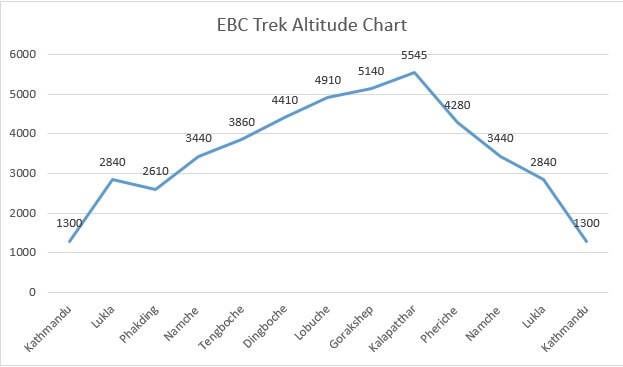
Everest Base Camp Trek Altitude Summary
When you think about trekking in the Everest region, the altitude is the major factor that makes trekking in this region exceptional. Especially the Everest Base Camp Trek. The changing course of the altitude makes this trek one of the most challenging and adventurous journey, which one cannot find in any other place. At the very beginning of this journey, you will start off by landing at the Lukla airport which is situated at an elevation of 2,810 meters above sea level. From here on, the altitude varies from 2,500 meters to 5,545 meters. The walking period for the entire trek is 9 days. You will even have additional days for acclimatization, which is crucial for this trip.
You will feel the Himalayan air as you land at Lukla. At this altitude, the air you breathe in will feel entirely different from that of the congested Kathmandu city. From here, your trek starts towards Phakding where you descend along the Dudh Koshi River. From here, you ascend towards Namche Bazaar at 3,440 meters above sea level. You can already see how your journey takes you up and down in altitudes. From here on your checkpoints are situated at higher altitudes in succession, but the trail takes you through the usual ups and downs. From Namche, you trek through Tengboche (3860m), Pheriche (4280m), Dingboche (4410m), Dughla (4620m), Lobuche (4910m), Gorakshep (5140m), Everest Base Camp (5364m) and finally Kalapatthar (5545m). Kalapatthar is the highest point of the trek which sits further away from the camp. Due to its spectacular vantage point for the views of the Mt. Everest (8848m) and other surrounding mountains, Kalapatthar is a major part of this trek.
The high altitude trekking alone or the sudden changes in altitude can cause severe problems of altitude sickness. Thus, it is best to know about this disease and how to prevent it before going for the trek.
Altitude Sickness
The Everest Base Camp Trek, with its thrills and adventure, is surely a challenging trek. Due to its course along high altitudes, there are various obstacles that one can face during this trek. Altitude sickness is a major risk of the Everest Base Camp Trek. Altitude sickness is a critically important subject all travelers must know before going for any trek in the Himalayas. This sickness is a state when the body does not receive enough oxygen due to the low air pressure at high altitudes. The risk of getting altitude sickness generally starts at around an elevation of 2,400 meters above sea level. The atmosphere around and above this altitude contains lesser and lesser oxygen as it gradually increases. Thus, human bodies can find it hard to adapt to the changing levels of oxygen.
The reason behind Altitude Sickness
Altitude Sickness generally happens when a person ascends altitudes at a fast pace. The Everest Base Camp Trek takes you through varying ups and downs. If you are not able to maintain a pace which supports your body's ability to acclimatize to the atmosphere, you may fall victim to altitude sickness. Lack of acclimatization is the major reason which causes altitude sickness. Some of the most typical symptoms of altitude sickness are headache, nausea, vomiting, and lightheadedness. Additional symptoms include cough and gray, pale or bluish skin tone. However, symptoms can vary according to the level of altitude and a person's body. Symptoms of altitude sickness usually start showing around 12 to 24 hours of altitude ascension. If proper acclimatization is done, these symptoms can lessen within a day or two.
The solution of Altitude Sickness
Altitude sickness is a dangerous sickness that cannot be cured. Once a person is affected by it, s/he must be brought to lower altitudes immediately. The descent is the best option to prevent altitude sickness. If you are able to take certain measures during the trek, you will definitely be able to prevent altitude sickness. First of all, comes regulating a proper pace and pattern. It is important to note that you must not exert pressure on your body by overestimating your abilities. Since the distance to be covered may be long during the trek, one may want to complete it as soon as possible. Try your best to avoid doing so. Rushing can cause more pressure on your body as you ascend more altitude at less time and cause you to get sick. Instead, by walking slow, you let your body acclimatize to the atmosphere and reduce the chances of getting sick. Another good tip is to stay hydrated throughout the trip. It is recommended that you drink up to 5 liters of water per day; do not dry out and fall weak. As you might be covering 500 - 600 meters of altitude per day, make sure you only change your sleep elevation no more than 300 to 500 meters. Lastly, medications such as Diamox can help you speed up the process of acclimatization. But make sure you only take such medications with the doctor’s permission.
Best Season to Travel
The Everest Base Camp Trek is a high altitude trek that takes place in the Himalayan region. As such, the Himalayan region experiences cold weather almost all year. However, there are certain months that the days become warmer and the weather is more pleasant for trekking. The average temperature of this region is around 25 degrees Celsius in the afternoon and -20 degree Celsius at night.
Most favorable Season
The most favorable time to do the Everest Base Camp Trek is spring and autumn. Both these seasons have similar average weather during the afternoon and night. These temperatures range from an average of 16 degrees Celsius in the afternoon and around -10 degree Celsius at night for areas above 3,500 meters. Walking is pretty easier as the trails are dry and the views are clear. You may also be able to cover larger distance or explore more as the days are longer. However, it does not mean that it is impossible to go for this trek during other seasons.
Reasons to avoid trek during the winter season
The major reason to avoid going during the winter season which starts from mid-December to February is that the high altitudes of 3,500 meters and above have a temperature drop of about -20 Celsius to -30 degrees Celsius or more. Snowfall can cause a delay in your trekking and extend your trekking days even more. It is also not a good idea to trek at low temperatures. The trek becomes harder due to the cold weather and you can also get frostbites, fever, or various other illnesses. Another season to avoid is the monsoon season that occurs from July to August. The lower altitude areas under 3,500 meters experience heavy rainfall and the region from 3,500 meters to 4,000 meters experience occasional rainfall. This can obstruct the views of the mountains and make trekking harder due to slippery trails.
Everest High Passes Trek
The Khumbu region consists of three major high passes: Kongma La (5,535m), Cho La (5,420m), and Renjo La (5,360m). The Everest High Passes Trek combines all three of these spectacular passes into one journey and gives you a memorable experience you can cherish for your lifetime. The adventurous journey of the Everest High Passes trek rewards you with a glorious view of the Everest along with its neighboring peaks and the diverse terrain of the Khumbu region. The trek first heads to the Kongma La Pass (5535m) and reaches the Everest Base Camp. Thereon, crossing the Cho La Pass (5420m), the trek makes a circuit after crossing Renjo La Pass (5360m). This wonderful journey, however, is long and requires up to 22 days for completion. As most of this trek is spent at high altitudes, this is an intensely challenging trek. This trek covers around 166 kilometers of distance overall. The highest point of this trek is at Kalapatthar where you get the best views of the Mt. Everest (8848m) up close.
Everest Gokyo Lake Trek
The Everest Gokyo Lake Trek takes you to the serene lake of Gokyo which rests embedded in between the glorious mountains. The opportunity to get to admire the turquoise-colored glacial lake of Gokyo is surely something you will not want to miss. The trails on this trek lead you through a path that is diverted from the regular path most treks in this region use. Thus, this treks has a beauty of its own in its isolation. The Everest Gokyo Lake trek takes you through the Sagarmatha National Park from where you get mesmerizing views of mountains such as the Mt. Everest (8848m), Cho Oyu (8188m), Makalu (8463m), Lhotse (8414m), and many more. With a total timeline of 14 days, the all-around distance of this trip is about 110 kilometers. Like any other trek in the Khumbu region, the Everest Gokyo Lake trek also takes you through varying altitudes. But the highest altitude it takes you is 5,360 meters at the top of Gokyo Ri.
Anyone who knows about the Himalayas definitely wants an opportunity to admire its grandeur at least once in their lifetime. But most of the trees that give you this opportunity are exhausting and strenuous. The Everest Panorama Trek brings you an easier way to experience the Himalayan beauty. The major highlight of this trek is the panoramic view of the Himalayas from the Tengboche Monastery in the Tengboche Village. The Mt. Everest (8848m), Lhotse (8414m), Nuptse (7861m), Thamserku (6608m), and Ama Dablam (6856m) are the mountains seen along the trek. Along with the spectacular scenery, the cultural exposure this trek gives you. In just 11 days you will cover a total distance of 67 kilometers where you will get to witness the natural as well as cultural beauty of this region. Compared to many other treks, this trek has slightly lesser ups and downs. Nonetheless, it starts from an elevation of 2,840 meters at Lukla and takes you to the highest point of 3,860 meters at Tengboche.
Everest Cho La Pass Trek
For those who want extreme adventure and thrill, and are ready to bear the strenuous journey, the Everest Cho La Pass Trek is the perfect trek to do! The Everest Cho La Pass Trek combines the Everest Base Camp Trek, Gokyo Lake Trek, and the Cho La Pass Trek into one mega bundle of adventure and joy. This is an extreme adventure trek that lasts up to 20 days and takes you up and down through high altitudes. With marvelous views of mountains such as the Mt. Everest (8848m), Nuptse (7861m), Lhotse (8414m), Ama Dablam (6856m), and many more. With cultural insight, while exploring Sherpa villages and the opportunity to explore the beautiful nature, the Everest Cho La Pass Trek is a wonderful journey. The trek runs a course of about 130 kilometers where your journey takes place between 2,840 meters of elevation at Lukla and 5,545 meters at Kalapatthar- the highest point of the trek. The Everest Cho La Pass Trek is one of the most difficult treks of the Khumbu region. Thus, this trek is only recommended for those who are in good physical shape and have intermediate experience in trekking.
Short Everest Trek
The Short Everest Trek is a trek designed for people who are limited on time but want to experience the beauty of the Mt. Everest (8848m). Very much like the Everest Base Camp Trek, the Short Everest Trek also unfolds the beauty of the Khumbu region to its trekkers. Within a time frame of just 7 days you will get to witness spectacular views of the Everest and its neighboring peaks such as; Lhotse (8414m), Nuptse (7861m), Thamserku (6608m), Ama Dablam (6856m), etc. Similar to the Everest Base Camp Trek, you will also experience ups and downs in altitude during this trek- but not as intense as the Everest Base Camp Trek. Out of the 7 days on this journey, you will be trekking for 4 days in which you will cover a total of around 46 kilometers. The highest point of the trek is at the Everest view hotel which is situated at an elevation of 3,962 meters above sea level.
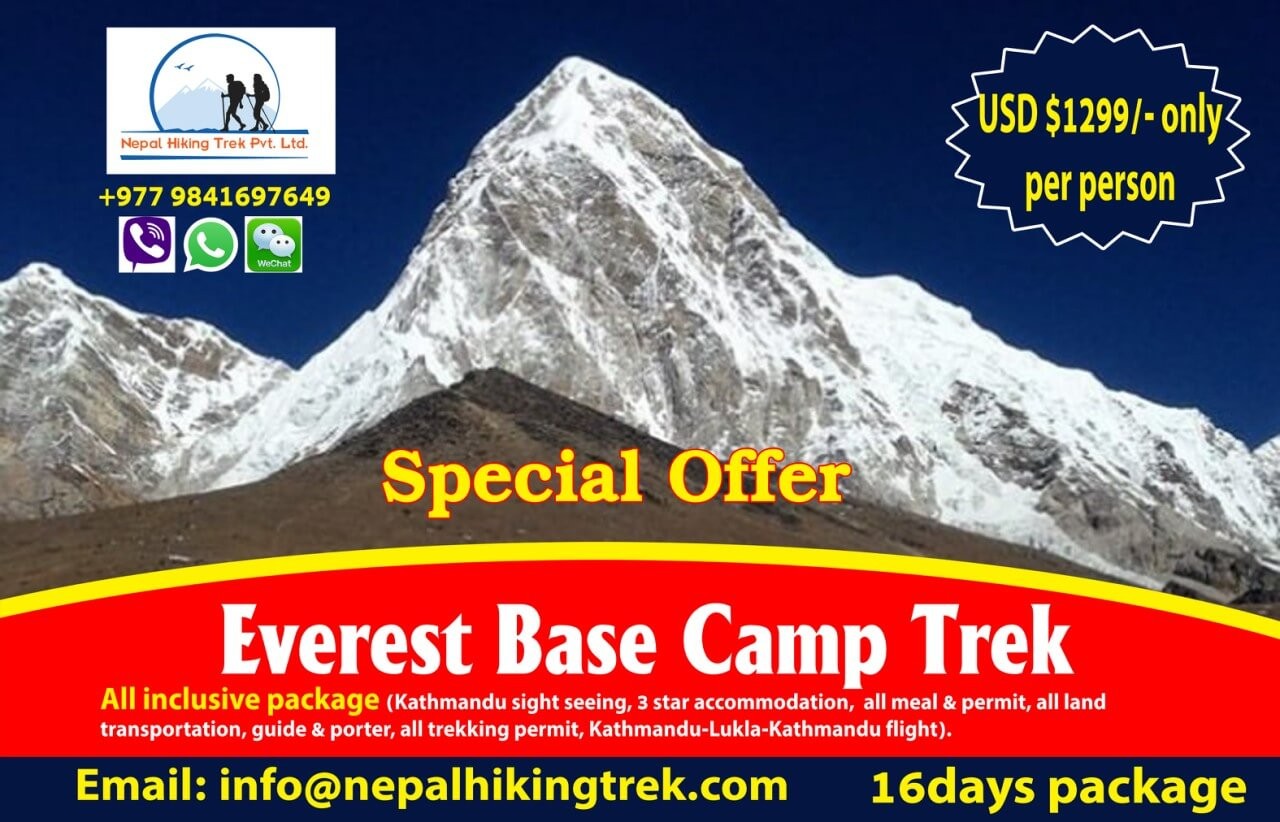
Packaging list while doing Everest Base Camp Trek
Packing your bags with the correct items is one of the most important parts of the trek. To be able to tackle the obstacles on the way, and stay comfortable and ready for the journey, you must have all the essential items. Your backpack must consist of clothing (depending on the season of travel), trekking equipment/gears, personal supplies, general medications, first aid kit, and a few personal items. However, you should always be careful to pack only the necessary items for the trek. A more in-depth packing list for the Everest Base Camp Trek is:
Clothing
- Light thermal inner wears
- Fleece jacket or pullover
- Wind-stopper jacket
- Waterproof jackets and trousers
- Lightweight thermal gloves
- Set of Undergarments
- Trekking Shorts
- Lightweight long trousers/pants
- Sun hat or scarf
- Warm fleece hat or light balaclava
- T-shirts (preferably sweat soaking)
- Thin, lightweight (inner socks)
- Thick warm wool hiking socks
- Waterproof shell mittens/gloves (insulated liners recommended)
- Insulated jacket with attached hood
- Heavyweight pants (for high elevations)
- Heavy down jacket
- Winter hat
Equipment/gears
- Trekking boots
- Camp sandals
- Sunglasses with UV protection
- Water bottles
- Trekking Poles
- Headlamp
- Sleeping bag (rated to 0 degrees recommended)
- Tent
- Sleeping pad/mat
- Silk Liner
Personal Supplies
- Medium-sized towel
- Toothbrush/Toothpaste
- Multipurpose soap
- Face and body moisturizer
- Nail clippers
- Sunscreen
- Hand sanitizer
- Face/body wipes
- Throat lozenges
- Lip balm
General Medication
- Plasters/Band-Aids
- Bandage for sprains
- Iodine or water filter
- General painkiller
- Antiseptic cream for cuts
- Blister medication
- Antibacterial throat lozenges
- Antibiotic tablets
- Oral rehydration salts
- Diarrhea medication
- Diamox (for altitude sickness)
In addition to these, you can take some personal belongings such as cameras, books, cards or anything to keep you entertained during spare time. Keep in mind that it is best to maintain the low weight of your luggage. Thus, do not carry things that are not essential during the trek.
If you have not bought or do not have the required items, you need not worry about it. You can either rent or buy it for good prices here in Nepal. There are various stores located in different locations in the major cities. You can easily find these stores and get what you want; for a really good price, you can get good quality equipment.
Conclusion
In conclusion, the Everest Base Camp Trek is a truly adventurous and wonderful trek. For its distance and altitude, people may find it challenging. But keep in mind that there are various ways to do this trek; all depending on how much time you want to invest for this trip. The altitude on this trek is definitely high; thus, you have to make sure you are well aware of the obstacles and how to overcome them. If you do your research on the trek and follow the given guidelines, you will truly have the best experience from this trek. for more details email us: [email protected] or [email protected]





